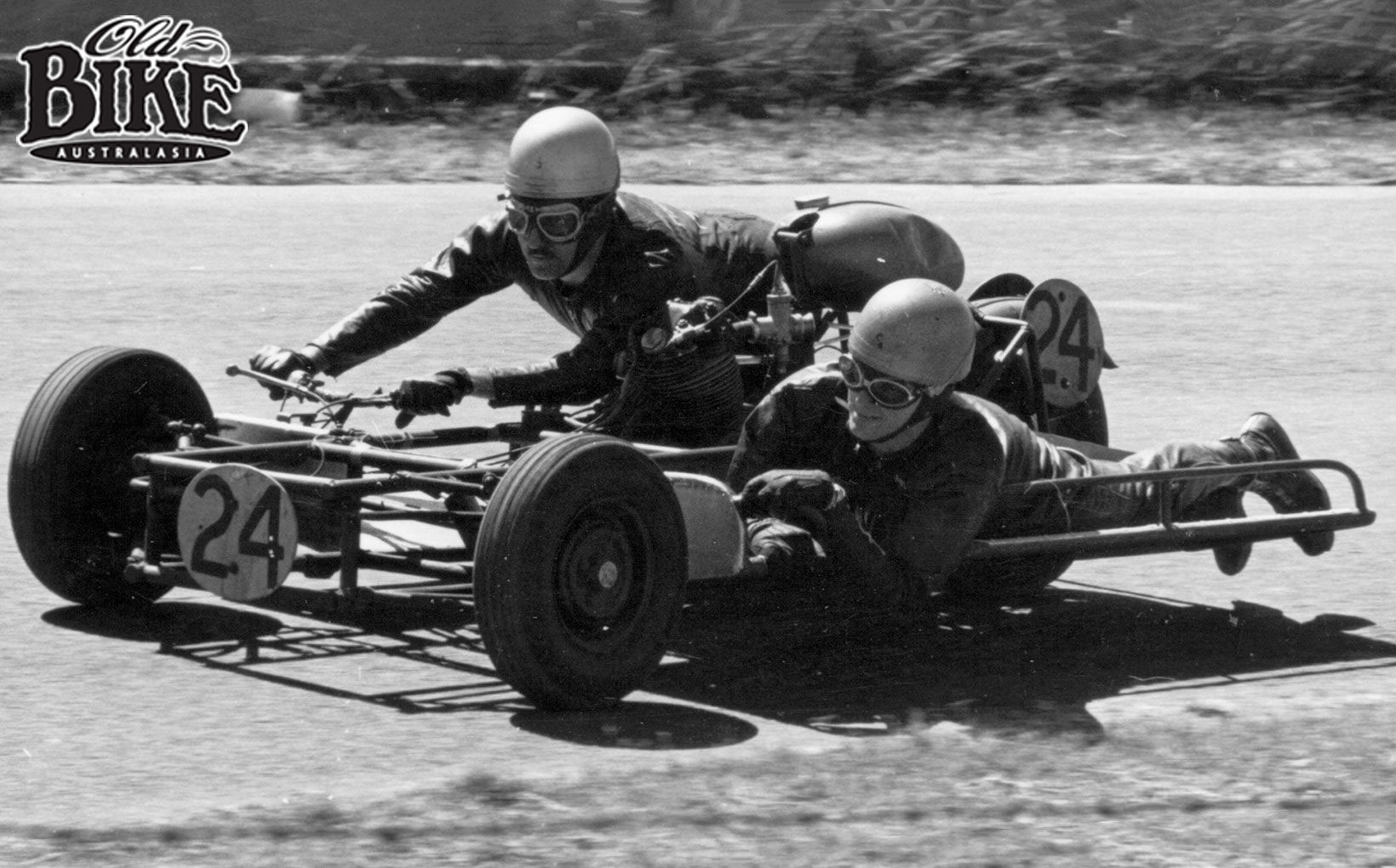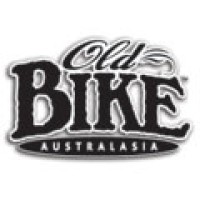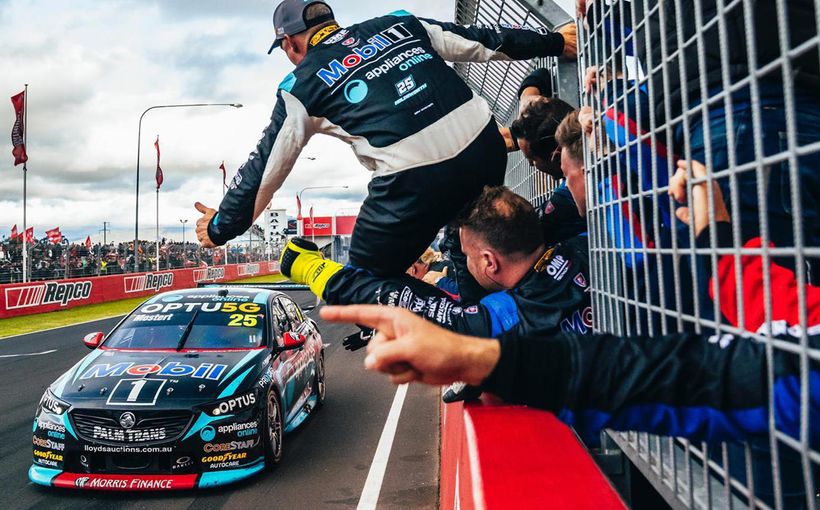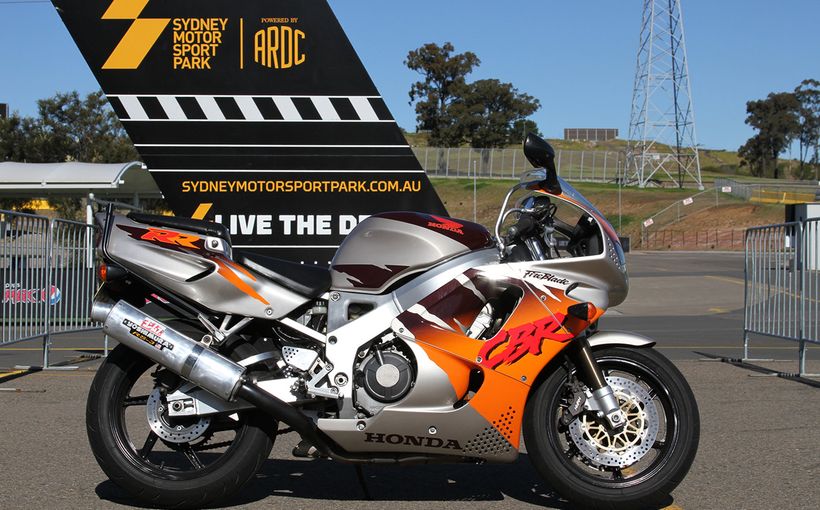
Story: Jim Scaysbrook Photos: Rob Lewis, Dick Darby, OBA Archives
They called him The Professor, and his acolytes were numerous in the fertile area for sidecar racers, Maitland, near Newcastle. John Dunscombe, who died in 2005, was a wiry little chap who lived in a terraced house in Charles Street, East Maitland – a dwelling absolutely crammed with goods and chattels collected over a bachelor’s lifetime. Most of his worldly possessions, including his cherished pistols (John was a keen and accomplished target shooter) were kept on the first floor; a move made after the infamous Maitland floods had ruined most of his possessions and filled the house with thick mud.
The district was also famous for its Short Circuits (also known as Miniature TTs and today, simply Dirt Track. Just about every town in the Hunter Valley had a track, as well as the nearby centres of Tamworth, Taree and Gunnedah. As a 20-year old, John scraped together enough money to collect a pile of components including a Triumph Tiger 80 engine and an ancient Norton rigid frame, and in 1957 made his Short Circuit debut at the Aberdeen track. It was hardly an earth-shattering introduction, but it set the scene for the next few decades.
The popularity of the Short Circuits was partially due to the fact that New South Wales had only one permanent road racing circuit – at Mount Panorama, Bathurst – an this was used but once a year. Nevertheless, Bathurst was the meeting, and John hankered for a crack the 6-kilometre mountain circuit. A well-worn 1954 7R AJS was acquired, but John’s only recollection of the AJS at Bathurst was that it was hard work getting it up the mountain, and even harder to stop it at the end of Conrod Straight.
A step up the ladder
John disposed of the 7R and began looking for something meatier. By chance, it was lurking in a shed just a few miles from his home. Around 1953, one Monsieur Garrot of Paris took delivery of a brand new Vincent Black Lightning. Just what he thought of it we may never know, but the machine soon went back to England, to dealers High Ride of Islington. From there it was acquired by Alec Bunt, who shipped it to his home in Charlestown NSW, just south of Newcastle. His first ride on the beast scared him so severely that he locked the Lightning in a shed and tried to forget about it. At one point Bunt’s brother purloined the bike and began terrorising the neighbourhood until Alec recovered it. To dissuade any further use, he removed one carburettor and hid it. News of the fabulous machine’s existence travelled around the district grapevine, and when Dunscombe heard of it he tracked it down and began a lengthy period of negotiation. Eventually he forked over £600 – the same price as M. Garrot had parted with when the Vincent was brand new.
It was mid-1959, and with no road racing on the calendar until the following Easter, John decided to enter the Vincent for the next meeting at the nearby Muswellbrook Short Circuit. Around a mile and a quarter in length, it included a long downhill straight that sorted the chaps from the children. As a C-Grader, John had potentially the fastest bike on the card, and won his way through heats and semi-finals to progress to the A Grade feature. The Vincent was pulling well over 100 mph on the oiled-dirt main straight, wheel spinning all the way.
The experience caused him to question the viability of the Black Lightning as a solo. Vincents absolutely dominated the sidecar scene, having won at Bathurst every year but one since 1947. Although he had little experience in welding, John constructed his own chair and headed to Bathurst with his dirt track rival Gordon Hellyer as passenger. The pair revelled in the experience without seriously challenging the established stars. In search of more rides he pressed the machine into service on the dirt tracks as well, and came within a wheel of defeating Hellyer’s 700cc Golden Flash BSA for the Australian Short Circuit Sidecar title at Muswellbrook in June 1960.
By this time, new road racing circuits were springing up all over the country; Oran Park and Amaroo Park in Sydney, Brisbane’s Lakeside, and Catalina Park at Katoomba. Abandoning the dirt, Dunscombe set about modifying the Vincent to make it a more competitive road racing package. He built his own front forks, modelled on BMW principles, a new frame and sidecar, smaller wheels and aluminium full bin streamlining. With this package he began to go places, scoring second in the 1961 NSW GP at Bathurst, and third place in both 1963 and 1964. In 1963 he also finished third in the Australian TT at Lakeside.

The birth of the bed
Although his Vincent outfit was pretty competitive against others of its ilk, the times were a’changing. Dunscombe reckoned a quantum leap was needed, and the inspiration came whilst devouring the latest copy of the English Motor Cycle News. A race report contained details of Owen Greenwood’s Mini, and later editions showed the even more radical Unorfordox –‘Cyclecars’ that exploited the existing Sidecar racing rules to the maximum. It set John’s fertile mind to work, and he decided to create his own 3-wheeler which would dispense with conventional sidecar wisdom. Although entered thereafter as a Vincent Special, the device came to be universally known as The Flying Bedstead, although John spurned this term and always referred to his creation as the ‘Cyclecar’.
Starting with a (reasonably) clean sheet of paper, he drew up a rig that used a basically square platform measuring 8-foot by 5-foot. 1.125” mild steel tubing was used for the chassis, with smaller tubing for ancillaries such as passenger handles and a bar across the rear of the rider’s compartment. The chassis was not flat; both side sections cantered at about 15 degrees inwards. At the rear, a Vincent swinging arm was employed with twin Girling spring/damper units and a dual braking system. Supplementing the standard Vincent rear brake was a disc from a Renault R12. A 13-inch rim was laced to the Vincent hub, but it was up front that the really radical thinking became apparent.
From a local car wrecking yard, John sourced various bits from an Austin A30, including the twin leading shoe brake drums, king-pins and other components. The front 10-inch wheels came from a Morris Mini Minor with a sway bar sourced from a Triumph Herald. The front cowling came from the bonnet of a Standard Vanguard, held in place by a sheet of marine plywood, with the fuel tank located just behind. The sole concession to rider comfort was a padded hump for chest support.
The engine was mounted in the centre of the platform. Initially, a Vincent Comet single-cylinder engine was fitted, running on 12.5:1 with Lightning cams and exhaust system. This was soon replaced by the Black Lightning unit.
One of the problems to be overcome was fuel-feed. In the space where the generator originally sat in the Black Lightning engine, John fitted a self-made fuel-pump, based on a mechanical SU unit. This drove a small eccentric, suspended in ball races which ran in an oil-bath. This would have meant turning the pump at engine speed, so to lower the revs, he reduced the stroke by 50%. To prime the engine, a small header tank sat above the rocker box. As soon as the engine fired, the pump took over and everything worked fine.
“I’d never had anything to do with car suspension, so I made a few mistakes to begin with”, he recalls. “I made up top and bottom wishbones of equal length, which proved to be wrong. When the suspension compressed, the front wheels tilted inwards, losing contact with the road. It also needed radius rods to adjust the toe-in. I could have done what Owen Greenwood did and use a steering box with a steering wheel, but that didn’t seem quite right to me – I was used to handlebars. So I made up a bell-crank which worked OK.”

Shock, horror
The 3-wheeler was barely completed in time for the 1966 Easter Bathurst meeting, and had not turned a wheel when it arrived at the circuit for practice. When Dunscombe wheeled the machine into the scrutineering tent, the officials went into a state of panic.
“They had never seen anything like it before and they went searching through the rule book to work out whether it was legal. Eventually they said that they would allow me out in the first practice session, at the rear of the field, and the Travelling Marshall would follow me and make a report on whether it was dangerous. I told them that I would know in one lap if it was dangerous or not, and it was. The slightest bump would cause the front suspension to get all askew, and the thing would dart sideways with no warning whatsoever. Obviously this would be no good in a packed field so I just put it on the trailer and headed home.”
The solution was to shorten the top wishbones, remount the Girling dampers and alter the degree of toe-in; an operation that transformed the handling. “After that it was perfectly predictable, but the officials still didn’t like the look of it.” Fellow competitors soon nicknamed the machine, “The Flying Bedstead” and one would have to admit that the description was apt. It was unlike anything else on the track, and it took a man with a ticker like John’s to tackle the daunting Mount Panorama circuit on it.
Originally the machine sat on three locally-produced Olympic GT Steel Radial tyres – 10 inch at the front and 13 inch rear. The rear cover soon wore out but when John went to replace it he found the tyres were no longer in production and was forced to switch to another brand on the rear. “It was unrideable’ he says. “I went back to the tyre dealer and told them it was hopeless and they told me I should fit the new rubber all round, which I reluctantly did, and it wasn’t too bad. At the same time I put a set of local copies of the Minilite mag wheels on the front and that helped to cool the A30 brakes as well as reducing unsprung weight.”
John reckons he eventually got the suspension just right, and points to period photographs to prove his point. “You can see from the photos that the front tyres are dead square to the road, which gave it good grip and fantastic braking. I could outbrake anyone on it.”

Staying in the race
In the latter stages of the machine’s development, the Vincent engine was replaced with a three-cylinder water-cooled Suzuki, which although fast and reliable, was not without its foibles. The expansion chambers ran over the top of the engine, and although they were wrapped in asbestos matting, managed to melt the nylon lining in the throttle cables. This jammed the throttle slides wide open after the 130 mph blast down Conrod Straight, and John was extremely lucky to point the machine down the escape road towards Bathurst township before he could bring it under control. The much lighter Suzuki powerplant also produced another problem. The previously adequate nose-cone now generated aerodynamic lift, elevating the front end at speeds above 125 mph! John cured this by constructing a triangular wedge-shaped wing structure, somewhat similar to Formula One thinking of the time.
But even with the machine well-sorted, John was facing another challenge. “By now it was the early seventies, and blokes were fitting big Japanese four-cylinder engines in kneeler frames. The last time I rode it at Bathurst I had a race-long dice with Bob Levy, who had a wedge-shaped outfit with a big Kawasaki engine and slick tyres. I would catch him over the mountain but I knew it was pointless trying to pass because he would blow me into the weeds down the straight every lap. On the last lap I made a big move on him at Murray’s Corner but lost out by a length in the run to the line. I finished sixth and they only paid prize money back to fifth, so I reckoned I was wasting my time.”
Somewhat disgruntled, John dismantled the Flying Bedstead in the back yard of his home. The chassis was propped against the side fence. The Black Lightning engine and cycle parts were once again united, and sold to a US buyer in 1992 for Aust $64,000 – a local record at the time.
Anyone who saw the Flying Bedstead in action can attest to not only John’s skill as a rider and engineer, but his bravery (and certainly that of his passengers), for it presented a fearsome sight. Prior to his death, aged 69, John maintained that he planned to rebuild the ‘3-wheeler’ with another Suzuki engine. John died in his sleep on September 18, 2006, and his death was not discovered until friends became curious after not seeing him around the district for a while. The clean up of the house and back yard was a massive operation and one of the last jobs was to chop down the tree that had grown through the floor plan and had now hoisted the whole chassis clear of the ground. The frame tubes were rusted away in many places, but the front suspension and even the original BSA fuel tank in the nose of the device were still there. I borrowed a ute and drove to Maitland and, with help from Paul Driver, loaded the Flying Bedstead aboard and took it to Peter Campbell in Goulburn. Peter has built (and raced) some of Australia’s most successful outfits, and is probably the best person to resurrect the Professor’s handiwork. One day…

Protect your Classic. Call Shannons Insurance on 13 46 46 to get a quote today.










